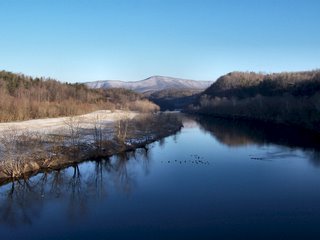Trail of the Trees; and Bird Watching

Winter is a great time for studying tree identification. The mountains look steel-gray from a distance. The forest, up close, is a study in muted earth tones. There’s smooth gray bark, scaly, nearly black bark, fissured gray bark and papery yellow bark to name a few. There are terminal buds, auxiliary buds and lateral buds. Twigs may be hairy (pubescent) or smooth (glabrous). By learning these characters and characteristics, you can turn a winter forest of cold gray and brown timbers into a living forest of black cherry, red maple, basswood, mockernut hickory, Southern red oak, Northern red oak, etc.
The Trail of the Trees can be accessed from the James River Visitor’s Center on the Blue Ridge Parkway at milepost 63.8. Elevation: 731 ft.

Image right: Canada Geese on the James River. Click image to enlarge.
This short 0.5-mile loop trail offers hikers river bottomland habitats, upland hardwood-hemlock forests, and several overlooks with views of the James River. This short self-guided tour can be productive for birders during spring and fall migration. On the river, one may find waterfowl such as blue-winged teal in the spring. Fall migration is more likely to bring fly-over migrants, such as broad-winged hawk, osprey, and common nighthawk. Nesting avian species include scarlet tanager, wood thrush, Baltimore oriole, and warbling vireo. Cliff swallows build their nests beneath the bridge, but patrol the river along with barn and tree swallows. In the winter, the river holds bufflehead, hooded merganser, and American black duck. However, during inclement weather, the Blue Ridge Parkway may be closed, so you may want to call ahead.
Images by D L Ennis
Technorati Tags: [Blue Ridge][James River][Bird Watching][Birds][forest][tree identification][Northern red oak][Southern red oak][mockernut hickory][black cherry][red maple][Blue Ridge Parkway][Canada Geese][Baltimore oriole][Hiking][Trails]












2 Comments:
At Thursday, 16 February, 2006, John B. said…
John B. said…
I think I have been to the spot you describe here. It is quite lovely. And I remember seeing the Cliff Swallows.
At Thursday, 16 February, 2006, D L Ennis said…
D L Ennis said…
Hey, John! Yes it is a lovely place, most of the time.
Post a Comment
<< Home